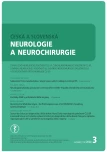Intracerebral haemorrhage in COVID-19
Authors:
P. Šmahel 1,2; J. Chmelař 1,2; L. Šimůnek 3; L. Siráková 2; V. Chovanec 4; Š. Rumlarová 1,2; E. Vítková 3; P. Prášil 1; S. Plíšek 1; A. Krajina 2; R. Chlíbek 2
Authors‘ workplace:
Klinika infekčních nemocí LF UK a FN Hradec Králové
1; Katedra epidemiologie, Fakulta vojenského zdravotnictví Univerzity obrany v Brně
2; Neurologická klinika, Komplexní cerebrovaskulární centrum, LF UK a FN Hradec Králové
3; Radiologická klinika, Komplexní cerebrovaskulární centrum, LF UK a FN Hradec Králové
4
Published in:
Cesk Slov Neurol N 2022; 85(3): 213-217
Category:
Review Article
doi:
https://doi.org/10.48095/cccsnn2022213
Overview
Most cases of SARS-CoV-2 infection are asymptomatic or have only mild respiratory symptoms. Patients with risk factors, including but not limited to advanced age, obesity, cardiovascular disease and immunosuppression, may develop a severe course of disease due to the development of a cytokine storm. COVID-19 is associated with an increased risk of bleeding and thromboembolic complications, with the gastrointestinal tract and CNS being among the most frequent sites of bleeding. One of the causes of vessel wall rupture and subsequent bleeding in COVID-19 may be dysfunction of the damaged endothelium. Viral infections are one of the most potent triggers of autoimmune diseases. One of the possible causes of haemorrhagic CMP is virus-induced acute vasculitis.
Keywords:
stroke – vasculitis – SARS-CoV-2 – COVID-19 – autoimmune disease – intracerebral bleeding
Sources
1. Naqvi AAT, Fatima K, Mohammad T et al. Insights into SARS-CoV-2 genome, structure, evolution, pathogenesis and therapies: structural genomics approach. Biochim Biophys Acta Mol Basis Dis 2020; 1866(10): 165878. doi: 10.1016/j.bbadis.2020.165878.
2. Burrell CJ, Howard CR, Murphy FA. Coronavirus – an overview. In: Burrell CJ, Howard CR, Murphy FA (eds). Fenner and White’s Medical Virology. 5th ed. London: Academic Press 2017: 437–446.
3. Hu T, Liu Y, Zhao M et al. A comparison of COVID-19, SARS and MERS. PeerJ 2020; 8: e9725. doi: 10.7717/peerj.9725.
4. Parasher A. COVID-19: current understanding of its pathophysiology, clinical presentation and treatment. Postgrad Med J 2021; 97(1147): 312–320. doi: 10.1136/postgradmedj-2020-138577.
5. Šmahel P, Chmelař J, Rumlarová Š et al. Diabetes mellitus 1. typu jako následek COVID-19. Diabetol Metab Endokrinol výživa 2021; 24(4): 159–167.
6. Otruba P, Bardoň J, Kolář M et al. Neurological complications of SARS-CoV-2 coronavirus infection (COVID-19). Neurol Praxi 2020; 21(Suppl G). doi: 10.36290/neu.2020.121.
7. Salamanna F, Maglio M, Landini MP et al. Body localization of ACE-2: on the trail of the keyhole of SARS-CoV-2. Front Med 2020; 7: 594495. doi: 10.3389/fmed.2020.594495.
8. Xu H, Zhong L, Deng J et al. High expression of ACE2 receptor of 2019-nCoV on the epithelial cells of oral mucosa. Int J Oral Sci 2020; 12(1): 8. doi: 10.1038/s41368-020-0074-x.
9. Baig AM, Khaleeq A, Ali U et al. Evidence of the COVID-19 virus targeting the CNS: tissue distribution, host-virus interaction, and proposed neurotropic mechanisms. ACS Chem Neurosci 2020; 11(7): 995–998. doi: 10.1021/acschemneuro.0c00122.
10. Beyerstedt S, Casaro EB, Rangel ÉB. COVID-19: angiotensin-converting enzyme 2 (ACE2) expression and tissue susceptibility to SARS-CoV-2 infection. Eur J Clin Microbiol Infect Dis 2021; 40(5): 905–919. doi: 10.1007/s10096-020-04138-6.
11. Ni W, Yang X, Yang D et al. Role of angiotensin-converting enzyme 2 (ACE2) in COVID-19. Crit Care 2020; 24(1): 422. doi: 10.1186/s13054-020-03120-0.
12. Herzig R, Mikulík R, Tomek A et al. COVID-19 and stroke. Cesk Slov Neurol N 2021; 84/117(1): 31–37. doi: 10.48095/cccsnn202131.
13. Varga Z, Flammer AJ, Steiger P et al. Endothelial cell infection and endotheliitis in COVID-19. Lancet 2020; 395(10234): 1417–1418. doi: 10.1016/S0140-6736(20)30937-5.
14. Ambrosino P, Calcaterra I, Molino A et al. Persistent endothelial dysfunction in post-acute COVID-19 syndrome: a case-control study. Biomedicines 2021; 9(8): 957. doi: 10.3390/biomedicines9080957.
15. Al-Samkari H, Karp Leaf RS, Dzik WH et al. COVID-19 and coagulation: bleeding and thrombotic manifestations of SARS-CoV-2 infection. Blood 2020; 136(4): 489–500. doi: 10.1182/blood.2020006520.
16. Syahrul S, Maliga HA, Ilmawan M et al. Hemorrhagic and ischemic stroke in patients with coronavirus disease 2019: incidence, risk factors, and pathogenesis – a systematic review and meta-analysis. F1000Res 2021; 10: 34. doi: 10.12688/f1000research.42308.1.
17. Leasure AC, Khan YM, Iyer R et al. Intracerebral hemorrhage in patients with COVID-19: an analysis from the COVID-19 cardiovascular disease registry. Stroke 2021; 52(7): e321–e323. doi: 10.1161/STROKEAHA.121.034215.
18. Himmels J. COVID-19 and risk factors for hospital admission, severe disease and death – a rapid review, 4th update. [online]. Available from URL: https://www.fhi.no/globalassets/dokumenterfiler/rapporter/2021/covid-19-and-risk-factors-for-hospital-admission-severe-disease-and-death--a-rapid-review-4th-update-report-2021.pdf.
19. Clark CE, McDonagh STJ, McManus RJ et al. COVID-19 and hypertension: risks and management. A scientific statement on behalf of the British and Irish hypertension society. J Hum Hypertens 2021; 35(4): 304–307. doi: 10.1038/s41371-020-00451-x.
20. Wang H, Tang X, Fan H et al. Potential mechanisms of hemorrhagic stroke in elderly COVID-19 patients. Aging (Albany NY) 2020; 12(11): 10022–10034. doi: 10.18632/aging.103335.
21. Vaschetto R, Cena T, Sainaghi PP et al. Cerebral nervous system vasculitis in a Covid-19 patient with pneumonia. J Clin Neurosci 2020; 79: 71–73. doi: 10.1016/j.jocn.2020.07.032.
22. Takeyama R, Fukuda K, Kouzaki Y et al. Intracerebral hemorrhage due to vasculitis following COVID-19 vaccination: a case report. Acta Neurochir (Wien) 2022; 164(2): 543–547. doi: 10.1007/s00701-021-05038-0.
23. Silverman M, Devlin M, Krawczyk M. Risk of hemorrhagic stroke in patients with coronavirus disease 2019. JAMA Neurol 2021; 78(4): 496–497. doi: 10.1001/jamaneurol.2021.0117.
24. Al-Samkari H, Gupta S, Leaf RK et al. Thrombosis, bleeding, and the observational effect of early therapeutic anticoagulation on survival in critically ill patients with COVID-19. Ann Intern Med 2021; 174(5): 622–632. doi: 10.7326/M20-6739.
25. Pretorius E, Vlok M, Venter C et al. Persistent clotting protein pathology in long COVID/post-acute sequelae of COVID-19 (PASC) is accompanied by increased levels of antiplasmin. Cardiovasc Diabetol 2021; 20(1): 172. doi: 10.1186/s12933-021-01359-7.
Labels
Paediatric neurology Neurosurgery NeurologyArticle was published in
Czech and Slovak Neurology and Neurosurgery

2022 Issue 3
Most read in this issue
- Neurological symptoms associated with COVID-19 based on a nation-wide online survey
- Effects of electrical stimulation according to Jantsch on spasticity – a pilot study
- Stanovisko Sekce pro diagnostiku a léčbu bolestí hlavy
- Intracerebral haemorrhage in COVID-19
